Review: Roden 1/48 T-28B
History:
The North American T-28 began life in 1946 as the XSN2J-1, which was designed to replace the SNJ trainer for the Navy. Looking like a tailwheel T-28, the design was not accepted by the Navy, but in 1947 the Air Force issued a specification for a new trainer to replace the T-6. It was to use the Wright R-1300 radial engine of 800 h.p. (The engine was an R-2600 cut in half), and should have tricycle landing gear to emulate the performance of a jet-powered aircraft. North American took up their failed Navy design and modified it to meet the Air Force requirements. In May 1948, the Air Force announced the selection of the BT-28, and North American proceeded to create two flying prototypes, which first flew on September 26, 1949. After completing flight tests, the Air Force ordered 266 T-28A Trojans in late 1949 and the first T-28As entered service in April 1950. The only complaint was that the airplane was somewhat underpowered with the R-1300 engine; this had been done deliberately to give the T-28 the feel of an early jet aircraft. The last T-28A rolled off the production line in 1953. The T-28A began leaving service in 1958. Cadet Norm Crocker remembered “When I was graduating flight school in 1959, I saw the T-28As being taken to the boneyard.”
The T-28 had a rather longer career with the U.S. Navy, the service for which it had originally been designed. The Navy's 428 T-28Bs were powered with the 1,425 h.p. R-1820 Cyclone. The T-28B was land-based only and used as an intermediate trainer and instrument rating trainer. This version was mostly phased out of naval service by the mid-1960s, with retired T-28Bs going to the VNAF as a COIN (Counter Insurgency) attack aircraft, serving with both the VNAF and USAF. The T-28Bs and early T-28Ds upgraded from former T-28As became prone to airframe failure with some losing wings; as a result restrictions were placed on high-G maneuvers. Some low-time T-28Bs were upgraded to AT-28D fully-armed attack aircraft. The 288 T-28Cs were strengthened for carrier operation with stronger landing gear and tail hooks. These aircraft were used as advanced trainers to carrier-qualify trainees up through the mid-1980s.
The T-28's service career in the U.S. military ended with the completion of the phase-in of the T-34C turboprop trainer. The last U.S. Navy training squadron to fly the T-28 was VT-27 "Boomers", based at Naval Air Station Corpus Christi, Texas, flying the last T-28C training flight in early 1984. The last T-28C in the Training Command, BuNo 137796, departed for Naval District Washington on March 14, 1984 for permanent display at Joint Base Anacostia-Andrews, in Washington, D.C.
T-28s were also operated by France, Argentina, Brazil, Bolivia, Democratic Republic of Congo, Cuba, Dominican Republic, Ecuador, Laos, Cambodia, South Vietnam, Haiti, Honduras, Mexico, Morocco, Nicaragua, Philippines, Saudi Arabia, Taiwan and Thailand.
The Kit:
Roden's T-28 is the first 1/48 kit to come along since the ancient, pre-Jurassic Monogram kit (which came out in 1956; I remember getting it as a graduation gift from elementary school).
Construction:
The kit really needs the Scale Aircraft Conversions metal landing gear, since the amount of weight it takes to make the model a nose-sitter is enough to overwhelm the weak plastic nose gear leg. Since I didn't have Terry Dean's nose weight set for this kit, which makes getting a nose-sitter much easier than filling the nose with fishing weights, I filled the nose with fish weights. As it turned out, there was plenty of room to stuff in some flattened weights between front of the fuselage and the forward end of the cockpit. However, with as many as I put in, the model will still tail-sit if tapped. Since the SAC landing gear wasn't available, I strengthened the plastic nosewheel leg by reinforcing it with CA glue allowed to “air dry.” The nose gear is still fragile enough that if you follow this route you need to always bear in mind to treat that part gently.
I didn't have a resin cockpit, and didn't really miss the awful True Details attempt. The Lone Star cockpit was unavailable, so I went with the kit parts. I sanded down the seats to get them thinner, and used the instrument panel decals from the kit sheet. I highlighted the side panel detail with a white artist's pencil. The cockpit was finished off with Eduard photoetch seatbelts.
While the parts are thick and somewhat “clunky”, if you take your time and clean them up, the model can be assembled with a minimum of filler needed. I only used filler on the fuselage centerline, top and bottom.
The wing and fuselage sub-assemblies came together without problem. I left off the flaps, which should be posed in the “down” position, until after the model was painted since they would be a different color from the rest of the airframe.
Colors and Markings:
Not trusting the kit decals, I searched out the Aeromaster “T-28 Trojans in the Sky” sheet. When it arrived, I decided to do the T-28B rather than the T-28C option, because the kit includes both lower rear fuselage parts and rudders and props for both, and because I had always wanted to do a T-28 in the earlier yellow scheme since the first Monogram kit I got as a kid.
While Errormaster claims the airplane had red stripes - which were never associated with a trainer - a google search for “photos of US Navy T-28B” quickly turned up an in-flight photo of the specific airplane the decals represent, with the pilot in the rear seat hidden inside the instrument training hood, which settles the question of the stripe color in favor of green, used to identify instrument rating trainers.
I first pre-shaded the model with blak airbrushed along panel lines. I followed that up with a light coat of flat white to aid the final coat of yellow, keeping it thin enough that the pre-shading showed through.
The U.S. Navy “Chrome Yellow” was mixed with Tamiya X-8 Lemon Yellow and X-6 Orange, with a dollop of X-24 Clear Yellow to intensify the color. The Willow Green was a mixture of 3 parts X-28 Park Green to one part XF26 Deep Green, with a small dollop of X-8 Lemon Yellow. The flaps, which were painted Engine Grey, were painted with XF-63 German Grey. I found out from my friend, legendary naval aviator Admiral Don Shelton, that the flaps were painted dark gray on the instrument trainers so those on the ground could verify they were down when the airplane was being flown in a “blind” landing under the hood; T-28s do not like landing without the flaps being deployed, and a low-time IFR trainee could get overwhelmed with landing workload and forget the flaps.
I painted the olive drab anti-glare panel then masked it off, then painted the green stripes and masked them off, then painted the model overall yellow.
The decals went down without problem, once I found an “8" the proper size and font to replace the “B” on the sheet - the unit was ATU-800, not ATUB00. Once the decals were set, I gave the model an overall coat of clear satin-gloss varnish.
I assembled the landing gear per the kit instructions, after painting the legs, wheels, inside of the gear doors and the wheel wells with Vallejo Aluminum. I also painted the leading edge of the flaps with Vallejo Aluminum and attached the flaps in the full-down position. The canopies were unmasked and positioned open; yes, the forward canopy is attached with the front edge lifted just a bit, as seen in photos. I finished off by attaching the prop and called it down.
Conclusions:
Yes, the Roden T-28 in all its versions is a “clunky kit” with thick parts. If you take care in cleaning them up and assembling them, the resulting model looks good. Any modeler with experience in limited-run kits should have no trouble with this kit. Remember, the alternative is now old enough to collect Social Security.





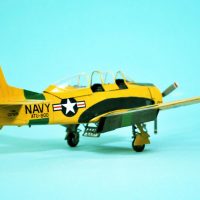









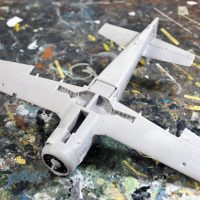
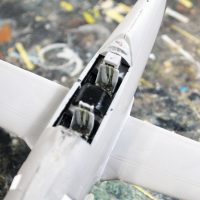


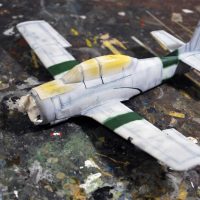







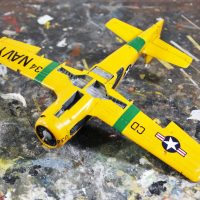

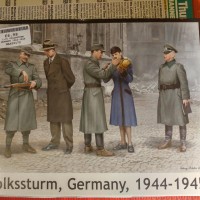



Looks good Tom...I have the T-28D kit and I broke the nose gear removing it from the sprue, so I ordered the metal gear already. Sounds like I need to order a nose weight while I am at it.
Yes. Get the metal gear. Even with strengthening mine, it wobbles and you don't want to think of turning it sideways with the nosewheel on the surface. You can get it to sit with fish weights. There was room for 2-3 more that would have made nose-sitting regardless.
If you're interested, there is a very neat decal sheet "T-28 - Trainers No More" that has T-28 Bs and Ds in Vietnam in the early days. I have the kit and have the sheet and I can tell I am going to like it.
Looks great ,Tom!
A bright yellow airplane. What’s not to like? Nice work, Tom. I followed your build with interest.
You’re right. That True Details cockpit tub really was awful. I’m sorry I made the mistake of using it.
A great build, Tom @tcinla.
The always difficult to apply yellow color turned out very well.
It was a pleasure to follow your progress in the groupbuild.
This is an amazing (and super-quick, as usual) job, @tcinla!
Loved the "historical intro": it covers all crucial aspects of the type's info.
Your build is truly superb, tackling a clunky, practically limited run kit, also tackling a challenging paint scheme.
Congratulations!
Lovely end result with the Roden kit!
Ill follow your tips on the Yellow painting method for eventually building my CL-415 ! I did not realise that’s a difficult color to put down well.
I remember seeing the T-28’s warming up on the run way in Leopold Ville during the long struggle of Independence for the Congo. I was 6 years old ... The days of long memories that keep coming back
Cuban mercenaries crewed the T-28 and strafed anything that moved and could be seen.
The Cubans were Bay of Pigs veterans working for the CIA.
That's a great-looking Trojan! Rarely see the yellow scheme.
Great job in a beautifull and bright yellow painting scheme.